|
|
|
Sort Order |
|
|
|
Items / Page
|
|
|
|
|
|
|
| Srl | Item |
| 1 |
ID:
191018
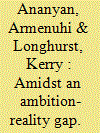

|
|
|
|
|
| Summary/Abstract |
Since 2000, the United Nations’ Women, Peace and Security (WPS) Agenda has addressed the causes and consequences of sexual violence towards women in conflict scenarios. After two decades of effort, an ambition-reality gap persists. Uneven commitments from UN member states, ongoing instances of conflict-related sexual violence around the globe and the lack of a critical mass of female participants in peace negotiations, security policy and politics in general, suggest that WPS has had limited effects. Despite its under-achievements, WPS objectives remain relevant, especially considering the amplifying effects that the Covid-19 pandemic and its fallout have had for gender inequality and conflict.
|
|
|
|
|
|
|
|
|
|
|
|
|
|
|
|
| 2 |
ID:
171204
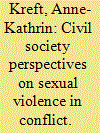

|
|
|
|
|
| Summary/Abstract |
In international policy circles, conflict-related sexual violence (CRSV) is commonly viewed as a weapon of war, a framing that researchers have criticized as overly simplistic. Feminist scholars in particular caution that the ‘weapon of war’ framing decontextualizes sexual violence in conflict from the structural factors of gender inequality that underpin its perpetration. In light of these tensions, how do politically relevant local actors perceive the nature and the origins of conflict-related sexual violence? Civil society organizations often actively confront conflict-related sexual violence on the ground. A better understanding of how their perceptions of this violence align or clash with the globally dominant ‘weapon of war’ narratives therefore has important policy implications. Interviews with representatives of Colombian women's organizations and victims' associations reveal that these civil society activists predominantly view conflict-related sexual violence as the result of patriarchal structures. The mobilized women perceive sexual violence as a very gendered violence that exists on a continuum extending through peace, the everyday and war, and which the presence of arms exacerbates. Strategic sexual violence, too, is understood to ultimately have its basis in patriarchal structures. The findings expose a disconnect between the globally dominant ‘weapon of war’ understanding that is decontextualized from structural factors and a local approach to CRSV that establishes clear linkages to societal gender inequality.
|
|
|
|
|
|
|
|
|
|
|
|
|
|
|
|
| 3 |
ID:
147832
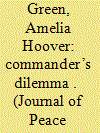

|
|
|
|
|
| Summary/Abstract |
This article proposes a framework for understanding variation in armed groups’ abilities to control wartime violence, including violence against civilians. I argue that patterns (both levels and forms) of violence are shaped by armed group leaders’ attempts to meet two conflicting imperatives. To succeed, commanders must build a fighting force capable of swift, unhesitating violence; they must also maintain some control over the level, form(s), and targeting of violence. I refer to this situation as the Commander’s Dilemma. Drawing on literatures from psychology and sociology, I argue that effective behavioral control cannot be achieved via extrinsic incentives (i.e. pecuniary or non-pecuniary rewards and punishments) alone. Rather, effective control of combatant violence depends upon armed group institutions intended to align combatants’ preferences with those of commanders. I therefore focus analytically on political education, the armed group institution most likely to operate in this way. In particular, I hypothesize that armed groups with strong and consistent institutions for political education should display, on average, narrower repertoires of violence than those without. This argument finds preliminary support in a cross-national analysis of reported rape by rebel forces, as well as a qualitative investigation of armed groups during civil war in El Salvador. More broadly, this approach suggests that the creation of restraint is at least as important to our understandings of wartime violence as the production of violence.
|
|
|
|
|
|
|
|
|
|
|
|
|
|
|
|
| 4 |
ID:
169940
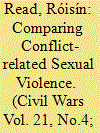

|
|
|
|
|
| Summary/Abstract |
This paper explores knowledge production about sexual violence and highlights the role that comparison, across contexts and between different kinds of knowledge, plays in shaping what we know. It explores the role of strategic knowledge in creating thematic areas of international expertise and draws attention to the roles quantitative evidence and narrative testimony evidence have played in this field of knowledge. The paper addresses the role that comparison plays in producing both quantitative and qualitative data about sexual violence in conflict and considers the functional similarities in the ways these data are deployed to support sexual violence campaigning and advocacy.
|
|
|
|
|
|
|
|
|
|
|
|
|
|
|
|
| 5 |
ID:
184137
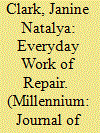

|
|
|
|
|
| Summary/Abstract |
This interdisciplinary article uses what Das has termed ‘the everyday work of repair’ as a framework for thinking about resilience. It is not the first to discuss resilience and the everyday. What is novel is the context in which it does so. Extant scholarship on conflict-related sexual violence has largely overlooked the concept of resilience. Addressing this gap, the article draws on semi-structured interviews with victims-/survivors of conflict-related sexual violence in Bosnia and Herzegovina (BiH), Colombia and Uganda to examine what everyday resilience ‘looks’ like and how it is expressed within and across highly diverse social ecologies. In so doing, it reflects on what everyday resilience means for transitional justice, through a particular focus on hybridity. It introduces the term ‘facilitative hybridity’, to underscore the need for transitional justice processes to give greater attention to the social ecologies that can crucially support and enable the everyday work of repair and everyday resilience.
|
|
|
|
|
|
|
|
|
|
|
|
|
|
|
|
| 6 |
ID:
155196
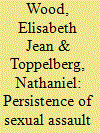

|
|
|
|
|
| Summary/Abstract |
What accounts for the puzzling persistence of sexual assault of both women and men within the ranks of the US military? Despite increasing efforts to end this intraforce violence, sexual assault of women persists at levels comparable to those in the civilian population and significantly higher than that of other crimes (data challenges prevent comparing rates for men). Drawing on recent analysis of rape as a practice rather than a strategy of war, we suggest the answer lies in the socialization not only of recruits but also of officers. We draw on an original typology of socialization processes and analysis of four well-documented cases to suggest the following account of why sexual assault persists. First, informal socialization processes (including sexualized hazing) trivialize sexual harassment and assault, establish assault as an appropriate form of punishment (including of those transgressing military gender norms), and license retaliation against victims who report. Second, officers sometimes sexually harass and assault subordinates, thereby endorsing similar acts by servicemembers under their command. Third, formal socialization processes of enlisted men and women, despite recent reforms, continue to reproduce a masculinity that undermines policies that seek to prevent sexual assault, in part because it fails to override these unauthorized and illegal socialization processes. Finally, the socialization of officers, combined with problematic incentive structures, undercuts efforts to end the de facto tolerance of sexual abuse by many officers. In our emphasis on horizontal as well as top-down socialization processes, and on those that subvert official policies as well as those that seek to inculcate them, we also contribute to scholarly understanding of socialization within organizations more generally.
|
|
|
|
|
|
|
|
|
|
|
|
|
|
|
|
| 7 |
ID:
192924
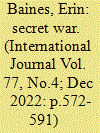

|
|
|
|
|
| Summary/Abstract |
Breaking the silence around wartime sexual violence is often understood as paramount to ending it. Many survivors feel compelled to publicly testify to prevent future harms, contest denial, and hold perpetrators to account. Yet, testimony is not always spoken, and silence should not be elided with powerlessness. In this article, we conceptualize the space in-between silence and voice as a form of multi-modal testimony that is given to protect, sustain, and reimagine relationships. We consider this in relation to the efforts of Adok, a woman abducted and forced into marriage by a rebel group in northern Uganda. Following her escape and return home with two children, Adok faced what is described as the “secret war”: ongoing structural and lateral violence. Her efforts to hold the father of her children to account attests to the “secret war,” and calls for a collective response to protect the future of her children.
|
|
|
|
|
|
|
|
|
|
|
|
|
|
|
|
| 8 |
ID:
171918
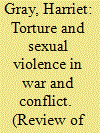

|
|
|
|
|
| Summary/Abstract |
Despite the wide repository of knowledge about conflict-related sexual violence that now exists, there remains a lack of understanding about how victims/survivors of such violence themselves make sense of and frame their experiences in conversation with global and local discourses and with the categorisations that underpin support programmes. Such sense-making is important not only because the ways in which violence is categorised shape a victim/survivor's ability to access particular forms of recognition and support, but also because it is central in how shattered selves and worlds are remade in the aftermath of violence. Drawing on individual and group interviews conducted with refugees living in Kampala, Uganda, this article charts how framings of ‘torture’ and ‘sexual violence’ become meaningful in participants’ accounts in the (re)formation of themselves as subjects after violent victimisation. We trace how participants navigate the heteronormative societal and legal norms that shape their subjectivity and the effects of the violence they experienced through the deeply gendered and political work that these terms do in their narratives. Our analysis thus highlights and reminds us to pay attention to the political stakes involved in fluid processes of categorising injury.
|
|
|
|
|
|
|
|
|
|
|
|
|
|
|
|
|
|
|
|
|